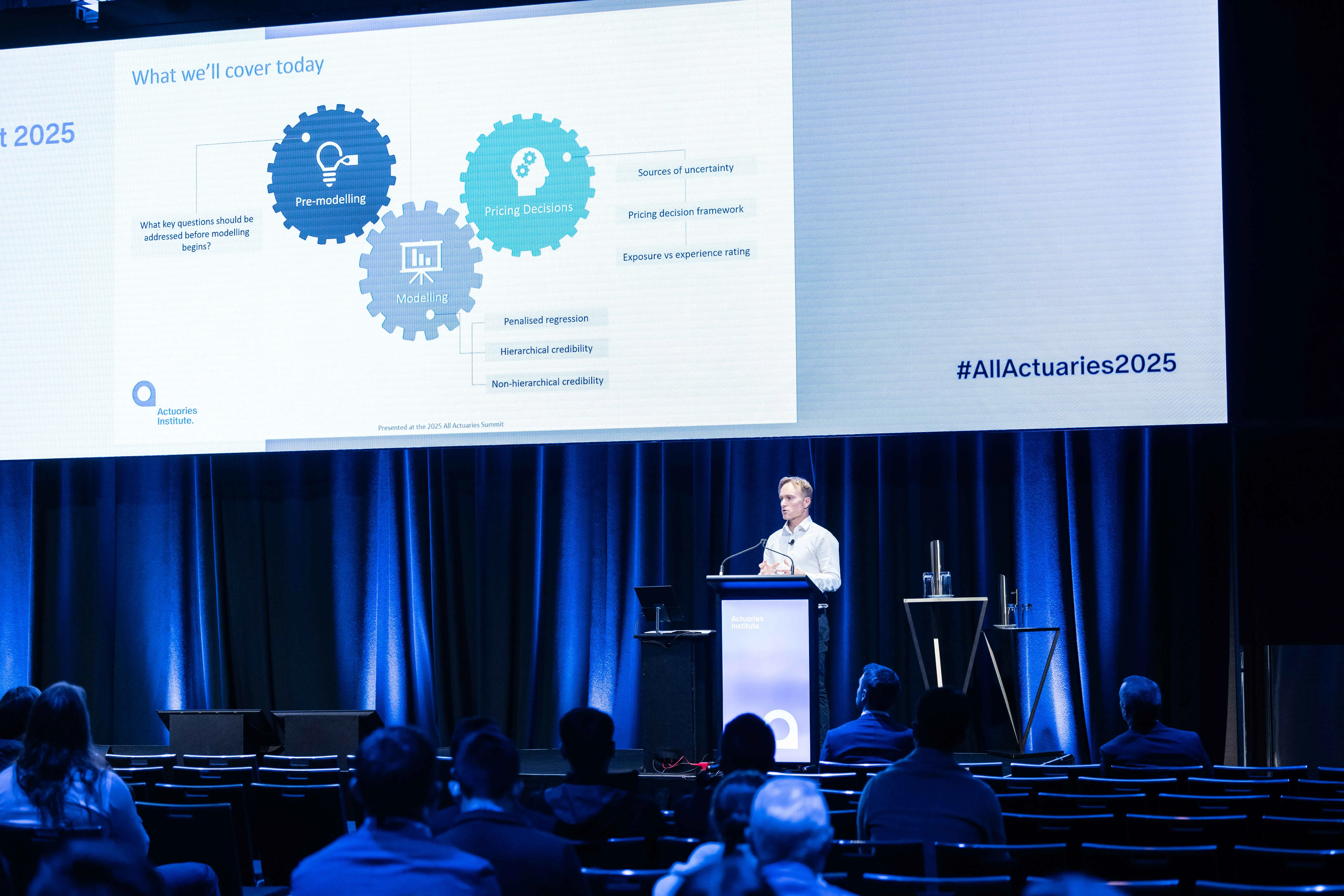Actuarial careers
Industry topics

Claim your CPD points
At the 2025 All Actuaries Summit, Navigating Uncertainty in Commercial Lines Pricing: Innovative Strategies and Practical Implications tackled the challenge of pricing commercial line products where data is limited, skewed or untrustworthy, leading to unreliable or deviating model results.
The presenters proposed a structured framework for navigating these uncertainties, focusing on three pillars:
This article recaps those key insights and explores how they can be practically applied to Private Health Insurance (PHI) pricing.

Tim Jeffrey presenting at Navigating Uncertainty in Commercial Lines Pricing: Innovative Strategies and Practical Implications All Actuaries Summit 2025 concurrent session
Sparse or volatile data can cause significant shifts in pricing models when left unchecked. To mitigate this, presenters recommended applying credibility weighting — shrinking results towards either:
This approach ensures pricing changes are data-justified and not driven by short-term noise (e.g., a single large hospital claim in a state with limited policy exposure).
In PHI, this is particularly relevant when setting premiums in smaller states or benefit categories with limited claims experience. The advantage of considering prior relativities is that premium increase year on year may be more stable and reduces the risk of customer dissatisfaction from a significant price spike in any one year.
Approach: Actuaries may consider incorporating penalty terms in GLMs or weighting factors to enforce credibility weighting and enhance pricing stability.
External references (like industry classifications) may not always be suitable for the purpose of calculating risk premiums. Presenters highlighted the value of expert hazard views — for example, underwriter insights in commercial lines.
In PHI, equivalent expertise might come from product managers or clinical service providers who understand utilisation constraints. For example, observed growth in psychiatric claims in Australia is a topic issue amongst all lines of insurers. The recent development of public system psychiatrists moving into private hospitals poses further uncertainty on whether PHI psychiatric claims will increase even more significantly due to resource constraints in public hospitals.
A service provider may have a view on how long such a disruption will last, and that future psychiatric costs should no longer be anchored to historical averages. Incorporating expert view early is advantageous in ensuring that the final pricing output has stakeholder buy-ins and that the premiums reflect the best estimate.
Approach: Embed SME input when defining risk groupings or assumptions to ensure models reflect forward-looking realities and gain stakeholders’ trust.
When no natural grouping exists, cluster analysis can be used to identify similar segments by location, behaviour or socioeconomic profile. This technique helps group heterogeneous risks into more high-level segments, improving efficiency and practicality in the analysis of the risks.
Beyond pricing, cluster analysis is also applicable in areas like lapse modelling, by identifying distinct features of customers that share similar lapse behaviours. Alternatively, clustering could potentially be applied in claimant profiling to identify risks and opportunities for improved health outcomes.
Whilst clustering provides data-driven insights to risk grouping, the results may not be intuitive and may be difficult to explain. Therefore, it will require a robust demonstration of model accuracy to gain stakeholder support.
Approach: Trial cluster models using distance metrics to identify similar segments, and use results to inform pricing, retention or wellbeing initiatives.
The presenters emphasised four sources of uncertainty in pricing: data quality, parameter estimation, model structure and process decisions.
As with any lines of insurance, uncertainty may stem from shifting customer mix and behaviour, regulatory, product and provider landscape change, as well as data system limitations. Clear communication on these uncertainties is important for pricing across all practice areas. Quantifying uncertainty with sensitivity analysis and confidence intervals can improve stakeholders’ confidence in their decision-making and inform how they manage any pricing and other risks.
Approach: Use visualisation tools to present the range of plausible outcomes and have a transparent decision framework in place that guides when commercial judgment overrides model output.

Roel Verbelen presenting at Navigating Uncertainty in Commercial Lines Pricing: Innovative Strategies and Practical Implications All Actuaries Summit 2025 concurrent session
While the presenters developed the pricing framework for commercial lines insurance, the framework addresses common pricing challenges: dealing with incomplete and inaccurate data, communicating pricing decisions and balancing judgment with evidence.
In today’s environment with rising affordability pressures, the ability to price accurately and explain decisions clearly is crucial. This rings especially true considering new product pricing and annual premium reviews in PHI are highly regulated, so the output from the approach discussed above may be informative only.
Another practical consideration is whether the framework is best applied to optimise pricing across the portfolio as opposed to individual product pricing, given there are many products each insurer needs to assess annually.